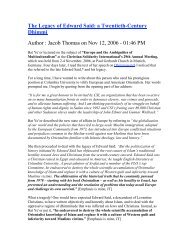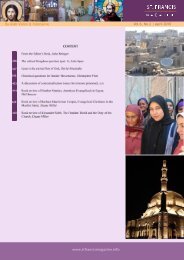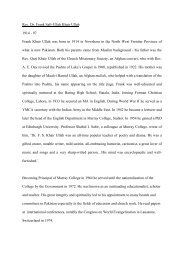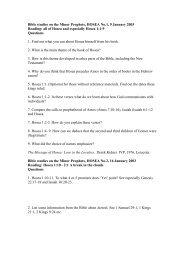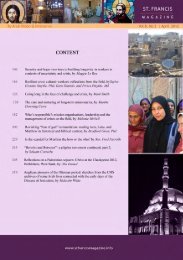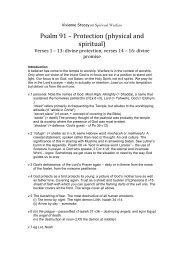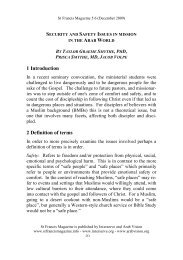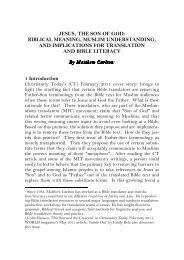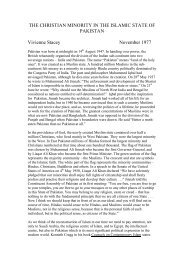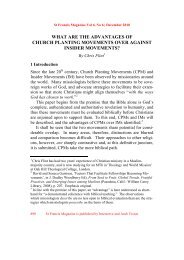download the pdf - St.Francis Magazine
download the pdf - St.Francis Magazine
download the pdf - St.Francis Magazine
Create successful ePaper yourself
Turn your PDF publications into a flip-book with our unique Google optimized e-Paper software.
<strong>St</strong> <strong>Francis</strong> <strong>Magazine</strong> Vol 8, No 4 | August 2012<br />
published by Cambridge University Press (Sleeman 2009), explores<br />
<strong>the</strong> productions of space and place undertaken in <strong>the</strong> Acts narrative<br />
generated by Jesus’ ascension into heaven. It covers Acts 1:1-11:18<br />
and, in my next work, I am extending this scope into <strong>the</strong> later chapters<br />
of Acts. This new area of study has brought <strong>the</strong> C5 / insider<br />
movement debates to my attention, initially via conversations with<br />
students on <strong>the</strong> Theology for Crossing Cultures course at Oak Hill College,<br />
London, <strong>the</strong> college at which I teach. 7 In due course, I intend<br />
to provide a more focused assessment of C5 / insider movements as<br />
viewed through an exegetical and hermeneutical lens which consists<br />
of <strong>the</strong> whole of Acts. This present survey prepares <strong>the</strong> ground for<br />
such work, as well as standing in its own right. To that end, as well<br />
as narrating <strong>the</strong> development of <strong>the</strong>se debates, it offers some prospective<br />
comments which will inform my own next steps which also,<br />
I hope, will assist o<strong>the</strong>rs engaging in <strong>the</strong>se matters.<br />
Important terms need clarifying, especially in a debate where<br />
<strong>the</strong>re are frequent intimations of people talking past each o<strong>the</strong>r (see,<br />
e.g., Higgins 2006: 120; Brogden 2010).<br />
Given <strong>the</strong> frequent summaries of <strong>the</strong> C1-C6 spectrum within <strong>the</strong><br />
literature (e.g. Travis 1998a; Tennent 2010: 303-305), I will not<br />
reiterate it at length here. Travis, who devised <strong>the</strong> spectrum, outlines<br />
well its six constitutive postures, establishing <strong>the</strong> ‘C’ as indicating<br />
Christ-centred communities – not, as Tennent (2006: 113n2)<br />
makes clear, ‘Cross-Cultural Church Planting Spectrums’. Position<br />
on <strong>the</strong> spectrum varies according to <strong>the</strong> language adopted for worship<br />
services, <strong>the</strong> cultural and religious forms employed in both<br />
public life and within explicit worship settings, and <strong>the</strong> believers’<br />
self-identity as Muslims or Christians. Tennent (2010: 303) describes<br />
Travis’ model as having become “<strong>the</strong> standard reference<br />
point for discussing contextualization in <strong>the</strong> Islamic context.” It has<br />
also been applied to o<strong>the</strong>r religious contexts (e.g. DeNeui 2005).<br />
7 In this regard, I am particularly thankful to Nick Jones, Ruth Markham (née<br />
Rotter) and Chris Flint, as well as to <strong>the</strong>ir tutor, Ray Porter. I am also very<br />
grateful to <strong>the</strong> Oak Hill College librarian, Wendy Bell, for her tireless help in<br />
tracing <strong>the</strong> literature.<br />
<strong>St</strong> <strong>Francis</strong> <strong>Magazine</strong> is a publication of Interserve and Arab Vision 453




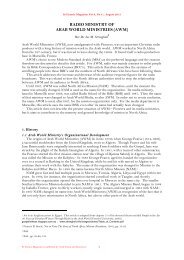
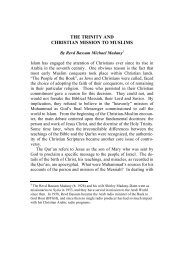
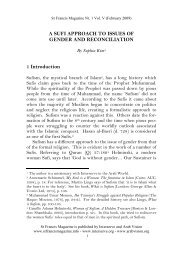
![Reflections on Surah Fatiha and the Lord's Prayer[1] - St.Francis ...](https://img.yumpu.com/49377951/1/184x260/reflections-on-surah-fatiha-and-the-lords-prayer1-stfrancis-.jpg?quality=85)
